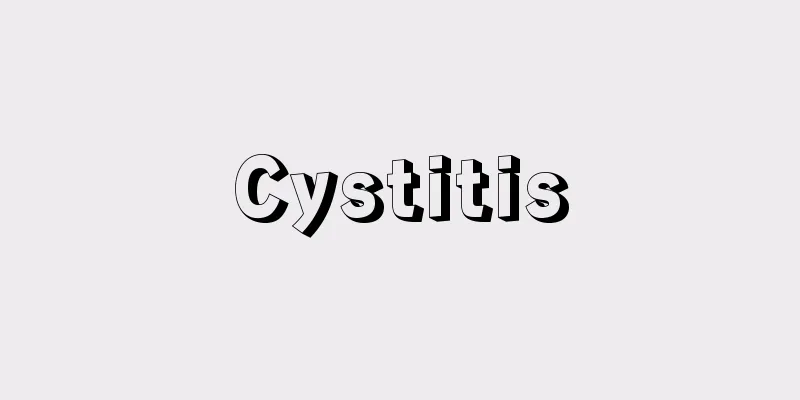Cystitis

|
What kind of disease is it? ●Main symptoms and course This is a disease caused by bacterial infection of the bladder. The initial symptoms are pain when urinating, frequent urination, and cloudy urine. Pain when urinating is a unique sharp pain that occurs after urinating. If left untreated, you will begin to feel pain in your lower abdomen not only when urinating but also all the time. There may be blood in the urine, and the urine will become darker toward the end of urination. Cystitis does not cause fever, but if the bacteria reach the kidneys from the bladder, it can cause pyelonephritis, with symptoms such as fever and back pain. Cystitis is generally divided into uncomplicated cystitis, which occurs in people with no underlying disease, and complicated cystitis, which occurs in people with some underlying disease and in situations where infection is likely to occur. ● Causes of the disease and how symptoms develop Most of the bacteria that cause the disease are Staphylococcus aureus or Escherichia coli. This disease is very rare in adult men, and most patients are women. Women have shorter urethras than men, making it easier for bacteria to invade. Bacteria that live in and around the anus migrate to the vagina, then invade the urethra and bladder, where they multiply and cause inflammation. People are more likely to get this disease when they hold in their urge to urinate for a long time, or when their body's resistance is weakened by fatigue or menstruation. Blood in the urine appears when the bladder mucosa is damaged by bacteria. People with kidney disease, diabetes, or immunosuppression who suffer from repeated infections are also more likely to get this disease. In such cases, the causative bacteria may be E. coli, Staphylococcus aureus, Klebsiella, Proteus, etc. ●Characteristics of the disease It is more common in infants, boys, and girls over the age of 2-3, and is particularly common in women in their 20s and 30s. It is thought that fatigue, sexual intercourse, pregnancy, childbirth, menstruation, etc. can lead to infection. EBM checks on common treatments and care [Treatment and care] Drink plenty of fluids [Rating] ☆☆ [Key points] Drinking extra fluids to increase urinary volume and flush out bacteria that may invade or are present in the bladder makes sense from a pathophysiological perspective and is supported by expert opinion and experience. [Treatment and care] Use of antibiotics [Rating] ☆☆☆☆☆ [Evaluation points] The effectiveness of antibiotics against cystitis has been confirmed by highly reliable clinical studies. (1) [Treatment and care] Avoid cold and overwork [Rating] ☆☆ [Evaluation points] Supported by expert opinion and experience. [Treatment and care] Urinating after sexual intercourse [Evaluation] ☆☆ [Evaluation points] This is a disease that is common among sexually active women, and the theory that urinating after sexual intercourse can help prevent it is supported by expert opinion and experience. Checking commonly used drugs with EBM Antibacterial drug [drug name] Bacta (sulfamethoxazole-trimethoprim) (1) [Rating] ☆☆☆☆☆ [Drug name] Baccidal (Norfloxacin) (1) [Rating] ☆☆☆☆☆ [Drug name] Tarivid (Ofloxacin) (1) [Rating] ☆☆☆☆☆ [Drug name] Ciproxan (Ciprofloxacin hydrochloride) (1) [Rating] ☆☆☆☆☆ [Drug name] Cravit (levofloxacin hydrate) (1) [Rating] ☆☆☆☆☆ [Drug name] Ozex/Tosuxacin (tosufloxacin tosilate hydrate) [Rating] ☆☆ [Drug name] Zithromax (azithromycin hydrate) [Rating] ☆☆ [Drug name] Meiact MS (cefditoren pivoxil) [Rating] ☆☆ [Drug name] Augmentin (amoxicillin hydrate, potassium clavulanate) [Rating] ☆☆ [Evaluation points] The effectiveness of sulfamethoxazole-trimethoprim, norfloxacin, ofloxacin, ciprofloxacin hydrochloride, and levofloxacin hydrate has been confirmed by highly reliable clinical studies. Other drugs are considered to be equally effective based on their action, and are supported by the opinions and experience of experts. Overall, the most reliable treatment method at present <br /> Different treatment approaches depending on whether or not there is an underlying disease Even with the same cystitis, the type of causative bacteria is different in people who have congenital or acquired abnormalities (malformations, stones, obstructions, etc.) in the bladder, ureters, or kidneys, who have a bladder catheter fitted, or who suffer from repeated infections due to diabetes or immunosuppression (complicated cystitis), and in people who have none of these factors (underlying diseases) (simple cystitis). Therefore, the basic approach to treatment is completely different. If there are no underlying diseases, sulfamethoxazole-trimethoprim or a quinolone antibiotic will be used.In people without underlying diseases, most cases of cystitis are caused by Escherichia coli or Staphylococcus aureus, and one of the following quinolone antibiotics is taken orally for at least three days: Bacta (sulfamethoxazole-trimethoprim), Baccidal (norfloxacin), Tarivid (ofloxacin), or Ciproxan (ciprofloxacin hydrochloride). If you have an underlying disease, use antibiotics that are effective against many bacteria. In people with underlying diseases, in addition to E. coli and Staphylococcus aureus, various causative bacteria must be considered, such as Klebsiella, Proteus, Seretzia, Pseudomonas aeruginosa, and Enterococcus. Therefore, until the causative bacteria is identified by urine culture, it is necessary to use antibiotics that are effective against many types of bacteria. Longer treatment (5 to 10 days) is required than for simple cystitis. Prophylactic antibiotics: Sexually active women who suffer from frequent cystitis may benefit from prophylactic antibiotics. (1)Gupta K, Hooton TM, et al. International clinical practice guidelines for the treatment of acute uncomplicated cystitis and pyelonephritis in women: A 2010 update by the Infectious Diseases Society of America and the European Society for Microbiology and infectious Diseases. Clin Infect Dis. 2011; 52: 103-120. Source: "EBM: A book that explains correct treatment" Information about the book "EBM: A book that explains correct treatment" |
|
どんな病気でしょうか? ●おもな症状と経過 膀胱(ぼうこう)に細菌が感染することによっておこる病気です。排尿痛、頻尿(ひんにょう)、尿の濁(にご)りが初期症状となります。排尿痛は排尿を終えたときにつーんとくる独特の痛みがあります。 放置すると排尿時だけでなく、ふだんも下腹部に痛みを感じるようになります。 尿に血が混じることもあり、排尿の終わりごろになって、とくに血尿の色が濃くなるのが特徴です。膀胱炎で熱がでることはありませんが、細菌が膀胱からさらに腎臓(じんぞう)にまで達すると、腎盂腎炎(じんうじんえん)をおこし、発熱や腰痛といった症状も現れます。 一般的に基礎疾患のない単純性膀胱炎と、なんらかの基礎疾患があり、感染がおこりやすい状況でおこる複雑性膀胱炎に分けられます。 ●病気の原因や症状がおこってくるしくみ 原因となる細菌はほとんどがブドウ球菌か大腸菌です。この病気が成人の男性でみられることは非常にまれで、多くが女性の患者さんです。女性は男性に比べて尿道が短いため、細菌が侵入しやすくなっています。肛門(こうもん)やその周囲にすみ着いている菌が腟(ちつ)に移行して、さらに尿道、膀胱へと侵入し、そこで増殖するため炎症がおこります。長時間尿意をがまんしたり、疲労や月経で体の抵抗力が衰えたりしているときにかかりやすくなります。細菌によって膀胱の粘膜が傷つけられると血尿がでます。また、腎臓の病気や糖尿病、免疫抑制状態にあって感染症をくり返しおこしている人などもかかりやすくなります。その場合、原因となる細菌は大腸菌やブドウ球菌に加えて、クレブシエラ菌、プロテウス菌などが考えられます。 ●病気の特徴 乳児では男の子が多く、2~3歳を過ぎると女の子に多く、とくに20~30歳代の女性に多くみられます。疲労、性交渉、妊娠、分娩(ぶんべん)、月経などが感染のきっかけになると考えられます。 よく行われている治療とケアをEBMでチェック [治療とケア]水分を多くとる [評価]☆☆ [評価のポイント] 水分を多めにとって尿量を多くし、侵入してくる、あるいは膀胱内にいる細菌を洗い流すことは病態生理学的には理にかなっており、専門家の意見や経験から支持されています。 [治療とケア]抗菌薬を用いる [評価]☆☆☆☆☆ [評価のポイント] 膀胱炎に対する抗菌薬の効果は、非常に信頼性の高い臨床研究によって確認されています。(1) [治療とケア]冷えや過労を避ける [評価]☆☆ [評価のポイント] 専門家の意見や経験から支持されています。 [治療とケア]性交渉のあとに排尿する [評価]☆☆ [評価のポイント] 性的な活動期の女性に多い病気であり、性交渉後の排尿が予防につながるとの説が専門家の意見や経験から支持されています。 よく使われている薬をEBMでチェック 抗菌薬 [薬名]バクタ(スルファメトキサゾール・トリメトプリム)(1) [評価]☆☆☆☆☆ [薬名]バクシダール(ノルフロキサシン)(1) [評価]☆☆☆☆☆ [薬名]タリビッド(オフロキサシン)(1) [評価]☆☆☆☆☆ [薬名]シプロキサン(塩酸シプロフロキサシン)(1) [評価]☆☆☆☆☆ [薬名]クラビット(レボフロキサシン水和物)(1) [評価]☆☆☆☆☆ [薬名]オゼックス/トスキサシン(トスフロキサシントシル酸塩水和物) [評価]☆☆ [薬名]ジスロマック(アジスロマイシン水和物) [評価]☆☆ [薬名]メイアクトMS(セフジトレンピボキシル) [評価]☆☆ [薬名]オーグメンチン(アモキシシリン水和物・クラブラン酸カリウム) [評価]☆☆ [評価のポイント] スルファメトキサゾール・トリメトプリム、ノルフロキサシン、オフロキサシン、塩酸シプロフロキサシン、レボフロキサシン水和物については非常に信頼性の高い臨床研究によって有効性が確認されています。ほかの薬についてもその作用から考えて同等の効果があると思われ、専門家の意見や経験から支持されています。 総合的に見て現在もっとも確かな治療法 基礎疾患の有無で異なる治療方針 同じ膀胱炎でも、もともと膀胱や尿管、腎臓に先天的あるいは後天的な異常(奇形、結石(けっせき)、閉塞(へいそく)など)があったり、膀胱カテーテルを装着していたり、糖尿病や免疫抑制状態などのため感染症をくり返していたりする人(複雑性膀胱炎)と、それらの要因(基礎疾患)がまったくない人(単純性膀胱炎)では、原因菌の種類が異なります。したがって、治療の基本的な方針もまったく異なってきます。 基礎疾患がなければスルファメトキサゾール・トリメトプリム、ニューキノロン系の抗菌薬を 基礎疾患のない人では、ほとんどが大腸菌かブドウ球菌を原因とする膀胱炎であり、バクタ(スルファメトキサゾール・トリメトプリム)、バクシダール(ノルフロキサシン)、タリビッド(オフロキサシン)、シプロキサン(塩酸シプロフロキサシン)などニューキノロン系の抗菌薬のうち、どれかを最低3日間、経口で服用します。 基礎疾患があれば多くの細菌に有効な抗菌薬を 基礎疾患のある人では、大腸菌、ブドウ球菌に加えて、クレブシエラ菌、プロテウス菌、セレチア菌、緑膿(りょくのう)菌、腸球菌など、さまざまな原因菌を考えなくてはなりません。したがって、尿培養で原因菌が明確になるまでは、多くの種類の菌に有効な抗菌薬を用いる必要があります。単純性膀胱炎よりも長期の治療(5~10日)が必要となります。 予防的な抗菌薬の服用も 性的に活動的な女性で、頻繁(ひんぱん)に膀胱炎をくり返すときには、予防的な抗菌薬の内服が効果的なこともあります。 (1)Gupta K, Hooton TM, et al. International clinical practice guidelines for the treatment of acute uncomplicated cystitis and pyelonephritis in women: A 2010 update by the Infectious Diseases Society of America and the European Society for Microbiology and infectious Diseases. Clin Infect Dis. 2011; 52: 103-120. 出典 法研「EBM 正しい治療がわかる本」EBM 正しい治療がわかる本について 情報 |
<<: King Beopheung (English: Pǒphǔng-wang)
Recommend
Treaty of Erzurum
...In the second half of the 10th century, the ce...
Tangerine orange
...includes the myrtle-leaf orange, which has ext...
Kyoritsu Women's College
An educational corporation (approved in 1951) with...
kōmōidia (English spelling) komoidia
...Needless to say, this does not diminish the un...
Riverboat Magistrate - Kawabunebugyo
〘Noun〙 One of the titles of the Edo Shogunate. It ...
Archipelago - Tatsuokai (English spelling)
(1) The former name of the Aegean Sea, which stre...
Bombelli, R.
...Ferrari is said to have demonstrated his abili...
Svear
…After that, trade with the Roman Empire, which e...
Keerthana - Keerthana
...Among these, there exists a singing style that...
Trachipterus iris (English spelling)
…[Isao Hanyu]. … *Some of the terminology that me...
Hama jujube (Japanese jujube) - Hama jujube (English name) Paliurus ramosissimus
A deciduous shrub of the Rhamnaceae family, also k...
Alhazen - Alhazen
The Latin name of Ibn al-Haytham. Source: About Sh...
IJF - IJF
The International Judo Federation was founded in 1...
Notacanthidae
...It preys on benthic organisms such as worms wi...
Manjuya Souji - Manjuya Souji
A townsman and scholar of the Sengoku period. His...









